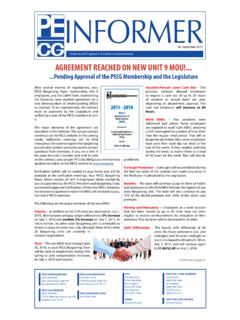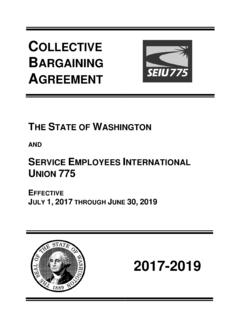Transcription of CONTRACT NEGOTIATIONS – Process and Status
1 Professional Engineers in California GovernmentPECG HEADQUARTERS(916) 446-0400455 Capitol Mall, Suite 501 Sacramento, CA 95814 PECG LOS ANGELES(818) 500-9941215 N. Marengo Avenue, Ste 185 Pasadena, CA 91101 PECG SAN FRANCISCO(415) 861-5720100 Pine Street, Suite 750 San Francisco, CA 94111 PECG INSURANCE INFO(415) 956-1344 FAXH eadquarters(916) 446-0489 Los Angeles(818) 247-2348 San Francisco(415) TOLL FREE NUMBERSS acramento(800) 338-1480 Los Angeles(888) 980-7324 San Francisco(844) 350-7324 VISIT PECG ON THE #1, March 2018 CONTRACT NEGOTIATIONS Process and StatusThe salaries, pensions, and working conditions for PECG members are established through NEGOTIATIONS between PECG and the Governor s Office, represented by CalHR.
2 For employees in Bargaining Unit 9, this occurs through NEGOTIATIONS which result in a binding CONTRACT (or MOU) approved by the PECG members, the Legislature, and the Governor. For the Supervisors and Managers, PECG meets and confers with CalHR and agreements are embodied in statutes, regulations, or policy letters, rather than a binding CONTRACT . The current MOU runs through June 30. As NEGOTIATIONS for a new MOU are underway, the following describes the Process to get from here to agreement. The Dills Act authorized collective bargaining for state employees in 1978.
3 A Labor Board established 21 Bargaining Units including Unit 9, the Professional Engineer Unit. The employees in the Unit voted and selected PECG as the exclusive representative. PECG s responsibilities include representing those employees for bargaining, grievances, and other functions. The current MOU for Unit 9 was negotiated in 2015 and expires this June. Prior to entering NEGOTIATIONS for a new MOU, the priorities of the Unit 9 PECG members were established in a survey. (A separate survey was conducted for PECG-represented Supervisors and Managers).
4 The results assist your Bargaining Team in negotiating a new CONTRACT . PECG and CalHR also conduct an annual salary survey of local public agencies in California to compare your salaries with your counterparts in those agencies. Your PECG Bargaining Team conducts NEGOTIATIONS on your behalf. It includes a Chair, who is elected annually by the members as the Vice President for Collective Bargaining, and five other PECG members selected from departments and geographical locations to represent a cross section of the Unit.
5 Your Team has begun meeting with CalHR and representatives of some of the departments which employ PECG members. Essentially, each party proposes items for the new CONTRACT . The teams negotiate which current CONTRACT items they wish to keep, delete, or change, as well as additional or new CONTRACT items. Of the 21 state Bargaining Units, only four are in active NEGOTIATIONS this NEGOTIATIONS continue through the end of June, the provisions of the current MOU continue to remain in effect. Eventually, your PECG Bargaining Team and CalHR reach agreement on all items and NEGOTIATIONS are completed.
6 PECG provides the members with information on the elements of the new CONTRACT and conducts meetings throughout the state to inform the members and answer questions. Meanwhile, the new MOU is sent to the Legislature to approve funding for any pay or benefit increases and to implement any changes in law which may be required. If the PECG members in Unit 9 vote to approve the CONTRACT , the Legislature adopts it, and the Governor signs the legislation, then the new CONTRACT takes effect. It is posted on the PECG and CalHR websites and PECG prepares printed copies for members who request them.
7 ---------------------------------------- ------------------Unit 9 CONTRACT NEGOTIATIONS are not a hostile battle with an adversary. PECG and CalHR have different goals. The bargaining Process is the way we work together to achieve those goals. Ultimately, the MOU is the result of that Process . Senator Richard Pan (fourth from right) welcomes PECG leaders in his Sacramento Office. Assembly Member Melissa Melendez (center) meets with Executive Director Bruce Blanning (left), and PECG leaders Scott Hongkham, Reyna Baeza-Oregal, and Jane Operations Agency Secretary Marybel Batjer, stops by to visit with PECG at the Legislative Member Kevin Kiley (center right) wraps up his meeting with some of his PECG member consituents.
8 State Controller Betty Yee (fourth from left) takes a moment with PECG President Sutida Bergquist (center) and several of our PECG Member Marc Berman (center) and CalPERS Vice President Henry Jones (second from right), take a selfie with PECG leaders. Assembly Member Bill Quirk (center) shares a laugh with PECG member Member Tim Grayson (center) with PECG s Mehrdad Nabizadeh and Mah-Mood leaders from throughout California converged in Sacramento earlier this month for PECG s 33rd Annual Legislative Day and Reception in the State Capitol. During the day, PECG leaders met with 96 State Senators, Assembly Members, and their staff in their Capitol offices.
9 In the evening, they were joined by numerous state officials for a reception under the Capitol Rotunda to make and renew acquaintances in a more informal LEGISLATIVE PRIORITIES FOR 2018 Implementing SB 1 Efficiently and Cost-EffectivelyPECG strongly supported SB 1, the transportation funding plan approved last year to provide stable, ongoing funding to repair and replace California s deteriorating state highways and bridges, and other transportation infrastructure. To ensure that SB 1 commitments are met and that new resources are spent wisely the state must:Hire Engineering Staff.
10 The Department of Transportation must hire the engineers and related professionals needed to deliver the billions of dollars of new state highway projects funded by SB 1. Unfortunately, fewer engineers work at Caltrans today than were on the job the day SB 1 passed. The department must dedicate itself to an effective hiring plan (as authorized in SB 1) to deliver the projects Californians expect and Outsourcing It Costs Twice as Much! Caltrans currently wastes over $100 million each year by awarding no-bid contracts to outsource nearly 1,000 engineering positions to consultants at twice the cost of using state engineers to perform the work.





